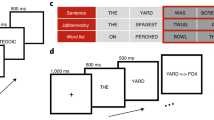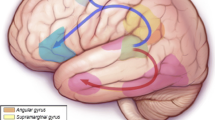Abstract
Illuminating the neural mechanisms subserving lexico-semantic processing is requisite to further understanding the neurophysiological basis of the dyslexias. Yet, despite numerous functional neuroimaging experiments, the location and temporal behavior of brain regions mediating word-level language processing remain an area of debate. Such investigations typically utilize the word/pseudoword contrast within hemodynamic measurements, and report several left hemisphere regions that respond more strongly to pseudowords but fail to replicate neural areas unique to real word processing. The present experiment addressed this problem from a different perspective. Mainly, we hypothesized that the time course, but not the neuroanatomy, would show within-subject across-condition disparities. For that purpose, we applied dipole-modeling techniques to high-density magnetoencephalographic recordings of healthy subjects, and utilized excellent spatiotemporal accuracy to demonstrate significant across-condition differences in the time domain, along with indistinguishable neural correlates within-subject. In all participants, both words and pseudowords elicited activity in left perisylvian language areas, with words consistently activating these regions ~100 ms earlier than pseudowords. Considerable functional heterogeneity was also observed, and this might underlie the inconsistencies among previous studies. We conclude that the neural distinction in word/pseudoword processing is not in spatial localization, but is better conceptualized as a dynamic difference in processing time.





Similar content being viewed by others
References
Alexander MP (2000) Aphasia I: clinical and anatomic issues. In: Farah MJ, Feinberg TE (eds) Patient-based approaches to cognitive neuroscience. MIT Press, Cambridge, pp 165–181
Assadollahi R, Pulvermüller F (2001) Neuromagnetic evidence for early access to cognitive representations. Neuroreport 12:207–213
Binder JR, McKiernan KA, Parsons ME, Westbury CF, Possing ET, Kaufman JN, et al. (2003) Neural correlates of lexical access during visual word recognition. J Cogn Neurosci 15:372–393
Breier JI, Simos PG, Papanicolaou AC, Zouridakis G, Wilmore LJ, Wheless JW, et al. (1999) Cerebral laterality assessment using magnetoencephalography: A comparison with the intracarotid amobarbital procedure. Neurology 22:938–945
Breier JI, Simos PG, Wheless JW, Constantinou JEC, Papanicolaou AC (2001) Hemispheric language dominance in children determined by magnetic source imaging. J Child Neurol 16:124–130
Brunswick N, McCrory E, Price CJ, Frith CD, Frith U (1999) Explicit and implicit processing of words and pseudowords by adult developmental dyslexics: a search for Wernicke’s wortschatz. Brain 122:1901–1917
Coltheart M, Rastle K, Perry C, Langdon R, Ziegler J (2001) DRC: a dual route cascaded model of visual word recognition and reading aloud. Psychol Rev 108:204–256
Cornelissen PL, Tarkiainen A, Helenius P, Salmelin R (2003) Cortical effects of shifting letter position in letter strings of varying length. J Cogn Neurosci 15:731–746
Coslett HB (2000) Acquired dyslexia. In: Farah MJ, Feinberg TE (eds) Patient-based approaches to cognitive neuroscience. MIT Press, Cambridge, pp 235–246
Devlin JT, Matthews PM, Rushworth MFS (2003) Semantic processing in the left inferior prefrontal cortex: a combined functional magnetic resonance imaging and transcranial magnetic stimulation study. J Cogn Neurosci 15:71–84
Embick D, Hackl M, Schaeffer J, Kelepir M, Marantz A (2001) A MEG component whose latency reflects lexical frequency. Cogn Brain Res 10:345–348
Fiebach CJ, Friederici AD, Müller K, von Cramon DY (2002) fMRI evidence for dual routes to the mental lexicon in visual word recognition. J Cogn Neurosci 14:11–23
Fiez JA, Balota DA, Raichle ME, Peterson SE (1999) Effects of lexicality, frequency, and spelling-to-sound consistency on the functional anatomy of reading. Neuron 24:205–218
Funnell E (1983) Phonological processes in reading: new evidence from acquired dyslexia. Br J Psychol 74:159–180
Hagoort P, Indefrey P, Brown C, Herzog H, Steinmetz H, Seitz RJ (1999) The neural circuitry involved in the reading of German words and pseudowords: a PET study. J Cogn Neurosci 11:383–398
Halgren E, Dhond RP, Christensen N, Van Petten C, Marinkovic K, Lewine JD, et al. (2002) N400-like magnetoencephalography responses modulated by semantic context, word frequency, and lexical class in sentences. Neuroimage 17:1101–1116
Hämäläinen MS, Sarvas J (1989) Realistic conductivity geometry model of the human head for interpretations of neuromagnetic data. IEEE Trans Biomed Eng 36:165–171
Hämäläinen M, Hari R, Ilmoniemi RJ, Knuutila J, Lounasmaa OV (1993) Magnetoencephalography: theory, instrumentation, and applications to noninvasive studies of the working human brain. Rev Mod Phys 65:413–497
Hari R, Salmelin R (1997) Human cortical oscillations: A neuromagnetic view through the skull. Trends Neurosci 20:44–49
Hari R, Salmelin R, Mäkelä JP, Salenius S, Helle M (1997) Magnetoencephalographic cortical rhythms. Int J Psychophysiol 26:51–62
Hari R, Levänen S, Raij T (2000) Timing of human cortical functions during cognition: role of MEG. Trends Cogn Sci 4:455–462
Helenius P, Salmelin R, Service E, Connolly JF (1998) Distinct time courses of word and context comprehension in the left temporal cortex. Brain 121:1133–1142
Helenius P, Salmelin R, Service E, Connolly JF (1999a) Semantic cortical activation in dyslexic readers. J Cogn Neurosci 11:535–550
Helenius P, Tarkiainen A, Cornelissen P, Hansen PC, Salmelin R (1999b) Dissociation of normal feature analysis and deficient processing of letter-strings in dyslexic adults. Cereb Cortex 9:476–483
Herbster AN, Mintun MA, Nebes RD, Becker JT (1997) Regional cerebral blood flow during word and nonword reading. Hum Brain Mapp 5:84–92
Hillebrand A, Barnes GR (2002) A quantitative assessment of the sensitivity of whole-head MEG to activity in the adult human cortex. Neuroimage 16:638–650
Kucera H, Francis WN (1967) Computational analysis of present-day American English. Brown University Press, Providence
Leahy RM, Mosher JC, Spencer ME, Huang MX, Lewine JD (1998) A study of dipole localization accuracy for MEG and EEG using a human skull phantom. Electroencephalogr Clin Neurophysiol 107:159–173
Maris E (2002) The role of orthographic and phonological codes in the word and pseudoword superiority effect: an analysis by means of multinomial processing tree models. J Exp Psychol Hum Percept Perform 28:1409–1431
Mechelli A, Gorno-Tempini ML, Price CJ (2003) Neuroimaging studies of word and pseudoword reading: consistencies, inconsistencies, and limitations. J Cogn Neurosci 15:260–271
Oldfield RC (1971) The assessment and analysis of handedness: the Edinburgh inventory. Neuropsychologia 9:97–113
Papanicolaou AC, Simos PG, Breier JI, Zouridakis G, Willmore LJ, Wheless JW, et al. (1999) Magnetoencephalographic mapping of the language-specific cortex. J Neurosurg 90:85–93
Patterson KE, Marshall JC, Coltheart M (1985) Surface dyslexia: cognitive and neuropsychological studies of phonological reading. Erlbaum Press, Hove
Paulesu E, McCrory E, Fazio F, Menoncello L, Brunswick N, Cappa SF, et al. (2000) A cultural effect on brain function. Nat Neurosci 3:91–96
Price CJ, Wise RJS, Frackowiak RSJ (1996) Demonstrating the implicit processing of visually presented words and pseudowords. Cereb Cortex 6:62–70
Pylkkänen L, Stringfellow A, Marantz A (2002) Neuromagnetic evidence for the timing of lexical activation: an MEG component sensitive to phonotactic probability but not neighborhood density. Brain Lang 81:666–678
Rumsey JM, Horwitz B, Donohue C, Nace K, Maisog JM, Andreason P (1997) Phonological and orthographic components of word recognition: a PET–rCBF study. Brain 120:739–759
Simos PG, Breier JI, Zouridakis G, Papanicolaou AC (1998) Assessment of cerebral dominance for language using magnetoencephalography. J Clin Neurophysiol 15:364–372
Simos PG, Papanicolaou AC, Breier JI, Wilmore LJ, Wheless JW, Constantinou JC, et al. (1999) Localization of language-specific cortex using MEG and intraoperative stimulation mapping. J Neurosurg 91:787–796
Simos PG, Breier JI, Fletcher JM, Foorman BR, Castillo EM, Papanicolaou AC (2002) Brain mechanisms for reading words and pseudowords: an integrated approach. Cereb Cortex 12:297–305
Tarkiainen A, Helenius P, Hansen PC, Cornelissen PL, Salmelin R (1999) Dynamics of letter string perception in the human occipitotemporal cortex. Brain 122:2119–2132
Tarkiainen A, Cornelissen PL, Salmelin R (2002) Dynamics of visual feature analysis and object-level processing in face versus letter-string perception. Brain 125:1125–1136
Tukey JW (1977) Exploratory data analysis. Addison–Wesley, Reading
Wagner H, Eiselt M, Zwienger U (1997) Exactness of source analysis of biomagnetic signals of epileptiform spikes by the method of spatial filtering: a computer simulation. Med Biol Eng Comput 35:708–714
Wydell TN, Vuorinen T, Helenius P, Salmelin R (2003) Neural correlates of letter string length and lexicality during reading in a regular orthography. J Cogn Neurosci 15:1052–1062
Xu B, Grafman J, Gaillard WD, Ishii K, Vega-Bermudez F, Pietrini P, et al. (2001) Conjoint and extended neural networks for the computation of speech codes: the neural basis of selective impairment in reading words and pseudowords. Cereb Cortex 11:267–277
Zouridakis G, Simos PG, Breier JI, Papanicolaou AC (1998) Cerebral dominance assessment using magnetoencephalography. Brain Topogr 11:57–65
Acknowledgements
TWW was supported by a pre-doctoral traineeship through the Center for Cognitive Sciences (NIH training grant T32 HD007151). Funding for ACL and PJP was provided by the Mental Illness and Neuroscience Discovery (MIND) Institute. This work was also supported by the US Department of Veterans Affairs, the American Legion Auxiliary, and the American Legion Brain Sciences Chair.
Author information
Authors and Affiliations
Corresponding author
Rights and permissions
About this article
Cite this article
Wilson, T.W., Leuthold, A.C., Lewis, S.M. et al. The time and space of lexicality: a neuromagnetic view. Exp Brain Res 162, 1–13 (2005). https://doi.org/10.1007/s00221-004-2099-3
Received:
Accepted:
Published:
Issue Date:
DOI: https://doi.org/10.1007/s00221-004-2099-3




